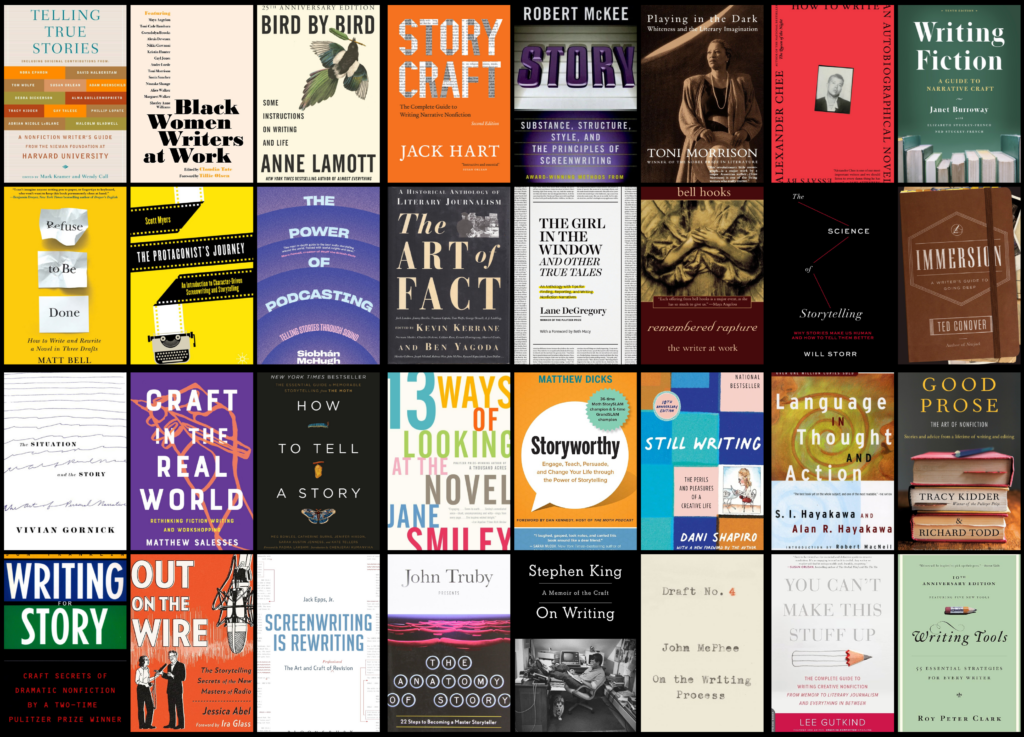Sign up for the Nieman Storyboard newsletter, delivered every Friday in your inbox.
***
Dear Storyboard community,
Forgive me in advance for sharing this potential source of procrastination and impulse buying.
We recently asked you for your favorite books on storytelling — and you delivered. Readers recommended more than 40 books on the craft of writing, reporting, and storytelling, across many forms and genres (and just in time for Independent Bookstore Day). Storyboard contributor Mallary Tenore Tarpley has compiled a list spanning nonfiction / journalism, fiction, podcasting, screenwriting, and telling stories onstage.
Here it is, from Aristotle to Zinsser:
For many of you, these were the books that helped shape your own award-winning work. Like acclaimed author Maurice Carlos Ruffin, who notes, "’Story' by Robert McKee is my Bible. The book is very much about telling writers to get out of their own way."
Our deepest thanks to all of you who contributed suggestions and insights on how these books informed your work and inspired you. We couldn't name everyone, but I'm grateful to this community for your generosity in sharing what you've learned.
We'll continue to update these pages over time, so keep the recommendations coming: editor@niemanstoryboard.org.
Letters to the Editor
Last week's newsletter — on archives, artifacts, and journalists preserving history — generated some notable letters:
"I wrote a story about the old municipal dock on the Mississippi River in Baton Rouge using digital archives almost exclusively. No one had written it previously and I was inspired during COVID. Few people were researching in person (certainly not I) and I was able to research and write part of it from the comfort of home because of access to the LSU databases that held digitized newspapers that covered Baton Rouge from the early 20th Century until the present. When COVID subsided, I began to use other sources. But your story in support of archives was most welcome — I agree completely. Libraries and archives must continue to be funded!"
— Author / writer Mary Ann Sternberg
"On the archiving tip, I've felt the same appreciation for what Ubuweb has done for avant garde, experimental, poetry, sound art, and other quirks (and treasures) of recorded history. It's been around for a few decades as a teeming repository of sonic delight and import, and has recently become more active again as other 'official' archives disappear and/or are dismantled. Archives as resistance, hell yeah!"
— Audio producer Julie Shapiro
Links of note
- Congrats to this year's nominees for the Peabody Awards, which were announced this week in the Documentary, News, Public Service, and Radio/Podcast categories. The winners of the 85th Annual Peabody Awards will be announced on May 1.
- ICYMI, from our sister site Nieman Reports: an important list of recommendations from a coalition of student media organizations, "revising long-standing guidance on journalistic practices in light of what it calls an 'unprecedented' threat to the free exercise of student speech on campuses across the United States."
- "One of the fundamental differences between a regular conversation and an interview is that an interview is a conversation with a destination." I loved this list of 11 "quick and dirty" interview tips for podcasts, radio, and live events from Elaine Appleton Grant at Sound Judgment.
- In Sarah Stillman's powerful new investigative story in The New Yorker, I am struck by the level of detail in the opening of the piece, which begins as a flashback in the lives of two children whose mother, Mary Faith Casey, was suffering from mental illness and ended up in and out of jail:
From jail, Mary would send sweet letters to her kids, festooned with hearts and stickers. “I love you,” she’d write Karina, “with the heart of a lion.” She’d often include an earnest token of maternal care: a rectangular card that promised, “This coupon entitles Karina to mucho hugs and kisses,” or a “Prayer for Stress” that read, “Quiet my anxious thoughts.” Both her children struggled. When friends from high school asked Karina where her mom was, she’d keep it vague—“San Diego,” she’d say. She and Carlin held out hope that their “real mom” would return: the good-natured woman who’d sewn their Halloween costumes by hand (a green T. rex for Carlin one year, and a sequined disco queen for Karina), and who, whenever they were sick, held a Gatorade bottle to their lips and a washcloth to their foreheads. “When she was on her medication, her daily life was completely different,” Karina told me. “We could tell right away when she’d been off it. She’d go into a tunnel, and we had to protect ourselves.”
Mary Casey starved to death after being held at the Pima County Jail in Arizona in 2022. Her family discovered that healthcare at the jail was overseen by a private company called NaphCare, part of a "multibillion-dollar industry" providing health and medical services to jails around the country. Stillman investigated more than 50 starvation and dehydration deaths in America's county jails, and through her thorough reporting and eye for the small moments, she brings us up close to those who have suffered.
Keep sharing your stories,
Mark Armstrong
Editor
Nieman Storyboard
Follow the Nieman Storyboard Podcast
On Bluesky: @niemanstoryboard.org
Subscribe to Storyboard
Get insights into the craft of journalism and storytelling in your inbox, delivered on Fridays.





